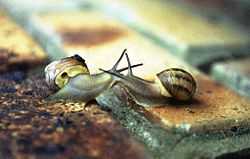Pasilalinic-sympathetic compass

The pasilalinic-sympathetic compass, also referred to as the snail telegraph, was a contraption built in an attempt to prove the misguided hypothesis that snails create a permanent telepathic link when they touch. The belief was developed by French occultist Jacques Toussaint Benoit and colleague Monsieur Biat-Chretien in the early to mid 19th century.
The supposed telepathic bond between the two snails was imagined to have no physical limit, thus making communication possible over any distance. By touching one half of the snail partnership it was suggested that the other snail would sense the contact and would move. Benoit built an apparatus to test his theories, but it quickly became apparent that what he expected to be a communication revolution was in fact just a costly failure.
The hypothesis
Benoit and Biat-Chretien believed that when there is contact between two snails a special type of fluid forms a link between them. This fluid forms an invisible thread that keeps the snails in "sympathetic communication" by using animal magnetism caused by an electric current pulsating along it.[1] Though this implies some form of physical link between the two snails it was still referred to as "telepathy".
Making a working model
Benoit did not have enough financial support to build his design. Benoit persuaded the Monsieur Triat, manager of a Paris gymnasium, to give him lodgings and an allowance, having impressed upon him the importance of his discovery. After a year Triat's patience grew thin and he demanded to see a working model.[1][2]
The apparatus
The apparatus consists of a square wooden box containing a large horizontal disc. In the disc are 24 holes, each containing a zinc dish lined with a cloth soaked in a copper sulphate solution; the cloth was held in place by a line of copper. At the bottom of each of the 24 basins is a snail, glued in place, and each associated with a different letter of the alphabet. An identical second device holds the paired snails.[1]
To transmit a letter the operator touches one of the snails. This causes a reaction in the corresponding snail which can be read by the receiving operator.[1]
Demonstration
On 2 October 1851 Benoit invited Triat and friend Jules Allix, a journalist from La Presse. He first asked Triat and then Allix to stand at one station and to spell out a word - he would then tell them what the word was by reading from the receiving end. However, he continually walked between the two devices and Triat began to suspect that it was a hoax. Allix was convinced by the demonstration and he wrote an article full of praise for Benoit's creation which appeared in the newspaper on 27 October 1851. Triat demanded a second, stricter test to which Benoit agreed. When the time came though Benoit had vanished.[1][2]
Coverage
Along with the Allix article in La Presse the story of the pasilalinic-sympathetic compass was covered by the 1889 book Historic Oddities and Strange Events by Sabine Baring-Gould.[2]
References in popular culture
- In the Japanese comic and animated series One Piece, a Den Den Mushi (or "Transponder Snail Phone") is a type of telephone where users can communicate via snail-like creatures.
- In the webcomic "Surviving the World," Dante references the Snail Telegraph in this comic: http://survivingtheworld.net/Lesson1744.html
References
- ↑ 1.0 1.1 1.2 1.3 1.4 Howard, Toby. 1995. "Progress at snail's pace". Accessed 28 May 2007.
- ↑ 2.0 2.1 2.2 2004. "The Snail Telegraph". Accessed 28 May 2007.